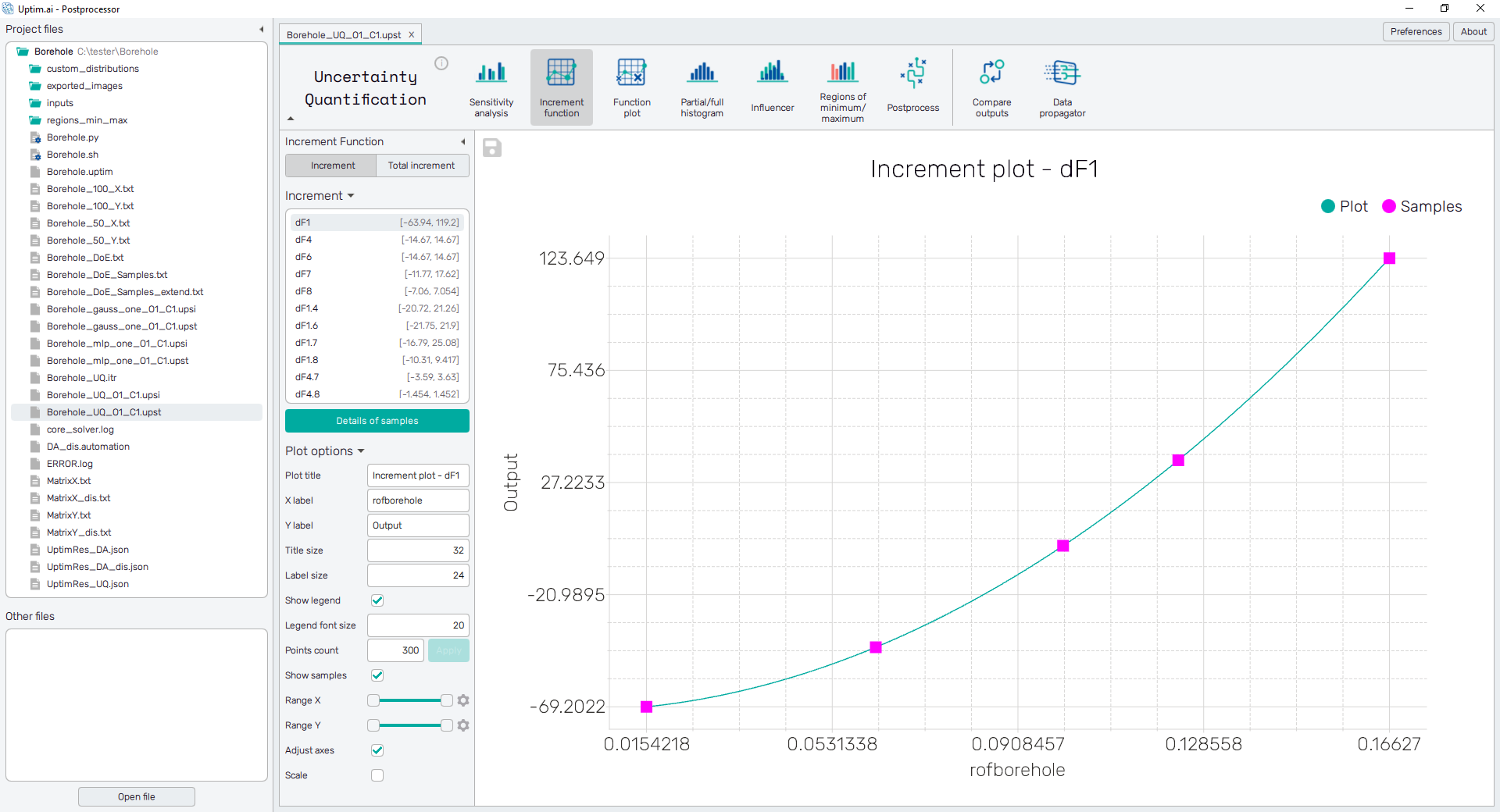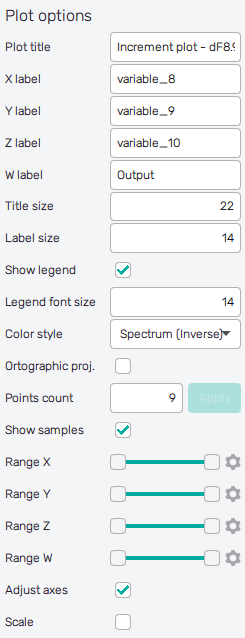Increment
The Increment Function Plot visualizes the influence of a selected increment function. This helps to search the domain of interest and fully understand the statistical aspects of a given problem. Based on the increment plots, the product can be improved or the research problem can be better understood. Moreover, each increment function shows a physical aspect of the problem, which can be used to set the direction for future development.
Theory behind
Each increment function adds a separate increment to the final model, which can be visualized. Each increment is visualized considering other variables in their nominal values. In order to closely explain this approach, let us consider the nominal sample (nominal design) to be and the function of interest is . We want to visualize the increment function , which represents the change of variable 1. The increment function plot is generated in the following way:
Increment function is at its nominal value, e.g. with .
The higher-order increment functions represent the increment for the interaction effects of a given problem, i.e. how the variables cooperate in order to influence the final problem, up to three-dimensional functions. Each increment function of a higher order considers other variables at their nominal value. In order to explain it more clearly, let us consider the previously mentioned problem, yet this time, we want to visualize the second-order increment function . The equation to plot reads:
From the above equation, it is clearly seen that the plot considers only interaction itself. Therefore, large peaks in one of the corners of the domain represent an interesting point which should be investigated closely. Note that the increment function is if one of the coordinates or is equal to the nominal value, e.g. with or .
How to use the interface
There is a collapsible box on the left side of the tab with the opened result file, where the user can set the data to be displayed. Increment and Total increment buttons on the top switch between these two sub-features. Under these buttons, there is a list of increment functions of the mathematical model. Items of the list are clickable to select the increment function to be displayed.

The type of the plot may vary depending on the order of the increment functions. It is possible to show functions with up to three interacting input variables. First-order functions are shown as solid color lines with the increment value on Y-axis of the plot. Second-order functions have the form of a surface, where the function value is also represented by the color of its fill. Coloring is the only way the function value is shown for third-order increment functions (interactions of three input variables). 3D plots can be rotated while holding the right mouse button and zoomed with the mouse wheel.
Left-clicking into the plot shows coordinates and corresponding increment values
in the plot.
Function values of samples used as the source to build the model are highlighted
in magenta. Exact values are available through the table shown on the Details of
samples button. It shows values of input variables corresponding to the currently
selected increment function and the value of the increment to the final model.
Note that all other input variables are considered to be coordinates of the nominal
sample. The table can be saved into a .csv file using the Export points to CSV
button.
To export the plot as a .png or .jpg file, the save-file dialogue can be induced
by clicking the 💾 icon on the top left of the plot.
It is possible to adjust the appearance of the plot using controls from
the Plot options section of the panel on the left. The list of controls
currently available may vary according to the selected increment function:
-
Plot title : Displayed above the plot, contains increment function designation by default.
-
X label : Label of the X axis, by default name of the first input variable involved in the selected increment function.
-
Y label : Label of the Y axis, output by default or name of the second input variable involved in the selected increment function of higher-order.
-
Z label : Label of the Z axis, output by default or name of the third input variable involved in the selected increment function of higher-order.
-
W label : Label of the colorbar/increment value scale, output by default.
-
Title size : Size of the title font.
-
Label size : Size of the label font.
-
Show legend : Switching on/off the legend of the plot/the colorbar scale.
-
Legend font size : Size of the legend font.
-
Color style : Selection menu setting the colormap of input variable values.
-
Orthographic proj. : Switch between orthographic (on) and perspective (off) projection of 3D plot.
-
Color style : Selection menu setting the colormap of input variable values.
-
Points count : Density of data along an axis for plot rendering. Confirmed with Apply button.
-
Show samples : Switch on/off source data points of the mathematical model.
-
Range X : Double-sided slider allowing to show a slice of the data in detail. Dragging one of the slider's points limits the depicted range of input variable value, one can move with the section along the X-axis by dragging the green bar of the slider (both edge points are highlighted).
-
Range Y : Double-sided slider allowing to show a slice of the data in detail. Dragging one of the slider's points limits the depicted range of output value, one can move with the section along the range of the output by dragging the green bar of the slider (both edge points are highlighted). In the case of 2nd order increment function limits values of the input variable along the Y-axis.
-
Range Z : Double-sided slider allowing to show a slice of the data in detail. Dragging one of the slider's points limits the depicted range of output value, one can move with the section along the range of the output by dragging the green bar of the slider (both edge points are highlighted). In case the of 3rd order increment function limits values of the input variable along the Z-axis.
-
Range W : Double-sided slider allowing to show a slice of the data in detail. Dragging one of the slider's points limits the depicted range of output value, one can move with the section along the range of the output by dragging the green bar of the slider (both edge points are highlighted).
All ranges in the plot can be also precisely using the ⚙ icon on the right of each slider. This opens a sub-dialogue with entry fields for writing exact values of range limits. These need to be confirmed with the Set button. Setting values outside domain's boundaries will reset range limits to the default state.
-
Adjust axes : Toggle if the axis and/or colorbar limits of the plot should be only the range adjusted with the slider above (on) or the full range of the input distribution (off).
-
Scale : Adjust the range of increment function value abscissa accordingly to the range of the given problem. The same range of function values is applied for all increment functions.
